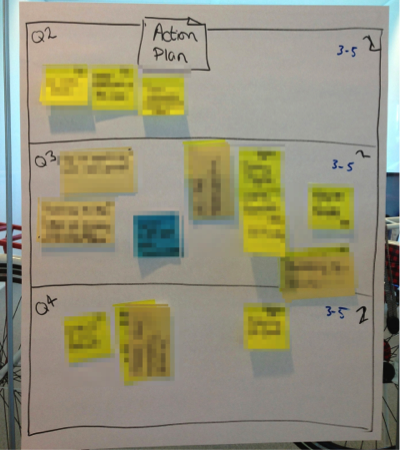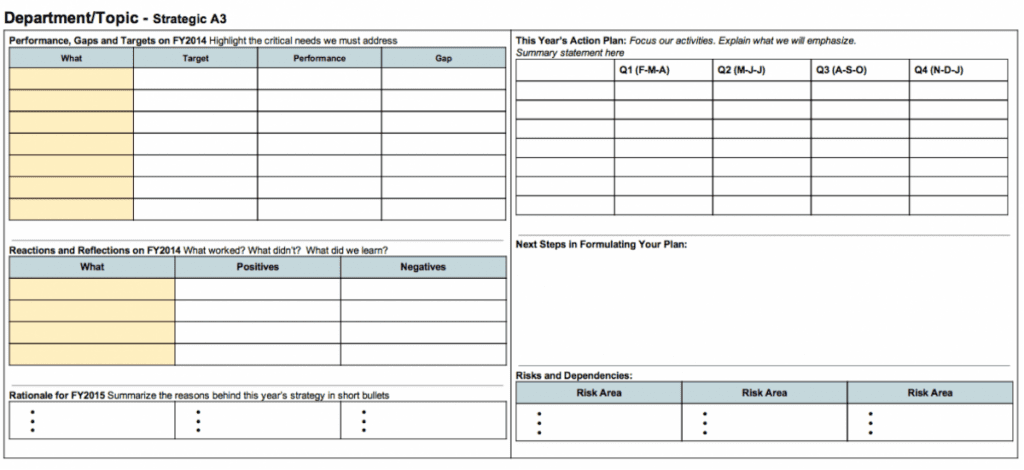This is another post originally published on the Rally Blog which I am reposting here to keep an archived copy. It was part of the same series as the one on annual and quarterly planning, in which we described various aspects of the way the business was run. Again, apart from minor edits to help it make sense as a stand-alone piece I have left the content as it was.
Strategy Deployment is sometimes known as Hoshin Kanri, and like many Lean concepts, it originated from Toyota. Hoshin Kanri is a Japanese term whose literal translation can be paraphrased as “compass control.” A more metaphorical interpretation, provided by Pascal Dennis in Getting the Right Things Done, is that of a “ship in a storm going in the right direction.”
Strategy Deployment is about getting everyone involved in the focus, communication, and execution of a shared goal. I described in previous posts how we collaboratively came up with strategies and an initial plan in the form of an X-matrix. The tool that we use for the deployment is the Strategic A3.
Strategic A3s
A3 refers to the size of the paper (approximately 11 x 17 inches) used by a number of different formats to articulate and communicate something in a simple, readable way on a single sheet of paper. Each rock or departmental team uses a Strategic A3 to describe its plan. This forms the basis for their problem-solving approach by capturing all the key hypotheses and results, which helps identify the opportunities for improvement.
The different sections of the A3 tell a story about the different stages of the PDSA cycle (Plan, Do, Study, Adjust.) I prefer this latter formulation from Dr. W. Edwards Deming to the original PDCA(Plan, Do, Check, Act) of Walter A. Shewhart, because “Study” places more emphasis on learning and gaining knowledge. Similarly, “Adjust” implies feedback and iteration more strongly than does “Act.”
This annual Strategic A3 goes hand-in-hand with a macro, longer-term (three- to five-year) planning A3, and numerous micro, problem-solving A3s.
Anatomy of a Strategic A3
This is what the default template that we use looks like. While it is often good to work on A3s using pencil and paper, for wider sharing across the organisation we’ve found that using a Google document works well too.
Each A3 has a clear topic, and is read in a specific order: down the left-hand side, and then down the right-hand side. This flow aligns with the ORID approach (Objective, Reflective, Interpretive, Decisional) which helps avoid jumping to early conclusions.
The first section looks at prior performance, gaps, and targets, which give objective data on the current state. Targets are hypotheses about what we would like to achieve, and performance shows the actual results. Over time, the gap between the two gives an indication of what areas need investigation and problem-solving. The next section gives the reactions to, and reflections on, the objective data. This is where emotions and gut feelings are captured. Then comes the interpretation of the data and feelings to give some rationale with which to make a plan.
The three left-hand sections help us look back into the past before we make any decisions about what we should do in the future. Having completed that we have much better information with which to complete the action plan, adding high-level focus and outcomes for each quarter. The immediate quarter will generally have a higher level of detail and confidence, with each subsequent quarter afterwards becoming less granular. Finally, the immediate next steps are captured and any risks and dependencies are noted so that they can be shared and managed.
Co-creating a Strategic A3
As you can probably imagine from reading the previous posts, the process of completing a Strategic A3 can be a highly collaborative, structured, and facilitated process. One team with which I work closely recently had grown to a point where we would benefit from our own Strategic A3, rather than being a part of a larger, international Strategic A3. To create it we all got together for a day in our Amsterdam office. We felt that this would allow us to align more strongly with the corporate strategy and communicate more clearly what we were doing, and where we needed help.
We began by breaking into small groups of three to four people, mostly aligned around a regional territory. These groups spent some time filling in their own copy of the A3 template. We then reconvened together and each group gave a readout of its discussions, presenting the top three items from each section, which we captured with post-it notes on flip charts. Having gone around each group I then asked everyone to silently theme the post-its in each section until everyone seemed happy with the results. This led to a discussion about each theme and identifying titles for them. We still had quite a few themes, so we finished off by ranking them with dot-voting so that we could be clear on which items were most important.
Our last step was to identify the top three items on the A3 that we wanted to highlight to the wider business. This turned out to be a relatively simple conversation. The collaborative nature of the process meant that everyone had a clear and shared understanding of what was important and where we needed to focus.


Corporate Steering
Strategy deployment is not a one-off, top-down exercise. Instead, the Strategic A3 is used as a simple tool that involves everyone in the process. Teams prepare and plan their work, in line with the corporate goals, and each quarter they revisit and revise their A3s as a means of communicating status and progress. As performance numbers become available an A3 will be updated with any changes highlighted, and the updated A3 then becomes a key input into Quarterly Steering.


